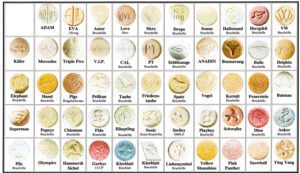
If there are certain things that parents have asked about drugs and their kids, it’s “what does this mean? ” “What does it look like?” “What should I look for?” All very common and not at all unique. Most parents don’t have any idea of the vast variety of drugs that are available to our children. The days of smelling the odor of marijuana or alcohol are the days of old. Our children have many more options for mind altering substances today. They are readily accessible and have been marketed by the dealers with very attractive names and packaging for young adults and children.
I hope to be able to give a little insight into identifying popular drugs that are being abused today. This is not easy for parents because there are so many different types of abused drugs. Through this blog, I will try to help you identity prescription drugs, illegal drugs and drug paraphernalia.
This week’s topic is on Ecstasy aka MDMA.
The abuser of the Club Drug will tell you that its not that bad. It is not addicting and everybody is doing it just to dance and feel good. Usually taken orally they come in small pills and will create effects that last around 5 hours
Street Names: Beans, Eve, X, XTC, STP, Peace, Lover’s Speed, E. MOLLY is a name used for the pure powder or crystalline version of MDMA. MOLLY is short for Molecule because it is pure and does not contain any additives like caffeine or or methamphetamine, or LSD.
How it is introduced to the body: Orally, crushed up and snorted, sometimes smoked. Different terminology used for dosages are, piggy-backing (taking doses throughout a period of time), Stacking (taking 3-4 pills at once), Candy flipping is when you take MDMA and LSD together to get the effect of the hallucinogen with the mellow effect of the MDMA.
Physiological Effects: MDMA affects the serotonin in the brain. Serotonin is used by the body to regulate mood, anger, aggression, sexual activity, sleep, and pain detection. MDMA increases the need for pleasure and stimulation. The person needs to be touched and held, and is very sensitive to touch.
Physical Effects: MDMA will create the same health risks in a person as other stimulants: increased heart rate, higher blood pressure, tremors, teeth clenching, nausea, chills, sweating, muscle cramps and blurred vision. A person taking MDMA can suffer from hyperthermia (sharp increase in body temperature). This can lead to kidney, liver, and or cardiovascular failure.
Being able to identify the dangerous drugs available within our communities gives parents knowledge that can be used to help educate and protect our children.
Michael Mercer